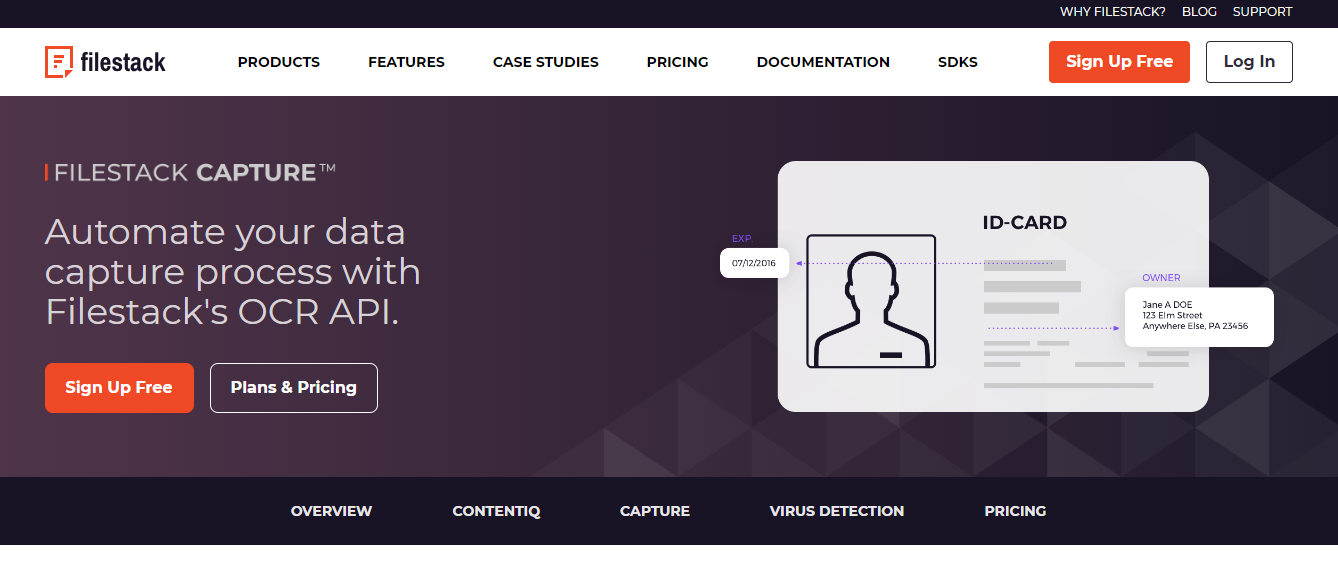Extracting and understanding data swiftly is crucial in today’s digital age. OCR data capture software has emerged as a powerful technology. Furthermore, it is revolutionizing the way we capture and process information. In this blog post, we will explore the significance of OCR in data capture. We will also explore how OCR data capture transforming assistive technologies.
OCR data capture software is a technology that converts printed or handwritten text into digital formats. Moreover, OCR can identify and extract characters from images using advanced algorithms and machine learning techniques. At the same time, it can also extract characters from scanned documents or live video feeds. This process not only saves time and effort but also enhances the accessibility and usability of information.
Accessibility and assistive technology play a vital role in empowering individuals with disabilities. By leveraging OCR, assistive technologies can bridge the gap between individuals and information available in text form. OCR-powered solutions enable visually impaired individuals to access printed materials through audio conversion or braille displays.
Let’s delve deeper into the incredible potential of OCR data capture in transforming assistive technologies.
What is the science behind OCR?
OCR, or Optical Character Recognition, is a remarkable technology that utilizes scientific principles to convert printed or handwritten text into digital format. The process involves mechanisms such as image scanning, preprocessing, and segmentation. It identifies the text and extracts it from the image.
AI and Machine Learning algorithms play a vital role in OCR by enabling image processing and character recognition. These algorithms learn to recognize and interpret various fonts, languages, and styles. Once it identifies the characters, OCR facilitates data capture by extracting, transforming, and loading (ETL) the text into usable formats. Hence, making it accessible for further analysis and manipulation.
The science behind OCR combines optics, computer vision, and machine learning advancements. It helps to unlock the power of digitizing printed information with remarkable accuracy and speed.
How did the development of OCR technology begin?
The development of OCR (Optical Character Recognition) technology traces its roots back to the mid-20th century. Initially, OCR relied on rule-based systems, where predefined patterns and templates helped to recognize characters. However, modern OCR has undergone a significant transformation due to AI and machine learning.
Today’s OCR systems leverage sophisticated algorithms, neural networks, and deep learning models. It helps to interpret and extract text from various sources accurately. In recent years, OCR technology has witnessed remarkable advancements. Innovations such as convolutional neural networks (CNNs) and recurrent neural networks (RNNs) have greatly improved the accuracy and speed of OCR systems.
Looking ahead, OCR technology aims for continued growth and innovation. Integrating natural language processing (NLP) and computer vision techniques will enable OCR to comprehend the context and extract meaning from text. Furthermore, the rise of mobile OCR applications and cloud-based OCR services will make this technology more accessible and convenient for users.
As OCR continues to evolve, it promises a future where information is effortlessly extracted. Hence, facilitating productivity, accessibility, and enhanced user experiences.
What are the common use cases of OCR in the real world?
OCR technology has multiple applications across various industries. Hence, it offers immense value and efficiency.
- OCR enables organizations to convert physical documents into searchable and editable digital formats. Hence, streamlining workflows and improving accessibility.
- Data entry automation is another common use case. OCR automates data extraction from invoices, forms, and receipts. Hence, reducing manual effort and minimizing errors.
- Additionally, OCR is vital in barcode and QR code reading. As a result, it facilitates inventory management, product tracking, and ticket scanning.
How does OCR work as an assistive technology?
OCR serves as a vital assistive technology by performing two key functions.
Firstly, it plays a crucial role in converting text into speech for visually impaired individuals. We can scan printed materials such as books, documents, or labels and process them into digital text. This text transforms into synthesized speech. Hence, allowing visually impaired individuals to access and comprehend written information.
Secondly, OCR enables the transformation of printed text into digital formats. Hence, facilitating editing and customization. Once it recognizes and extracts the text, it can also manipulate and edit using various software applications. This capability is particularly useful for individuals with reading difficulties.
What are the accessibility standards and regulations for OCR?
Accessibility is a fundamental principle that fosters inclusivity and equal access to information. Adherence to accessibility standards and regulations is crucial for maintaining quality.
The Americans with Disabilities Act (ADA) in the United States, Section 508 of the Rehabilitation Act, and the Web Content Accessibility Guidelines (WCAG) are prominent benchmarks in accessibility.
- ADA mandates that organizations make their digital content accessible to individuals with disabilities.
- Section 508 specifically focuses on electronic and information technology accessibility within the federal government.
- WCAG provides international guidelines for creating accessible web content.
Compliance with these standards and regulations is essential in OCR application development.
What are real-world applications or case studies of OCR promoting accessibility?
OCR technology paves the way for several real-world applications that promote accessibility and inclusivity.
Mobile reading apps for visually impaired individuals utilize OCR to convert printed text into audio formats. Hence, enabling them to access books, newspapers, and other textual content effortlessly.
Accessible PDFs and digital documents created through OCR ensure that individuals with visual impairments can access information independently.
Furthermore, OCR enables the creation of customized learning materials for dyslexic individuals. This becomes possible by converting text into dyslexia-friendly formats. Hence, enhancing their reading experience and comprehension.
What are the key considerations for building accessible OCR systems?
Building accessible OCR systems requires careful consideration of various factors. It aims to ensure inclusivity and usability for all users.
An accessibility-first approach is crucial in OCR development. Hence, prioritizing the needs of individuals with disabilities. Integrating OCR seamlessly with other assistive technologies enhances the overall accessibility of the system.
Designing for diverse user needs by incorporating universal design principles ensures that the OCR system caters to various abilities and preferences.
Developers can create OCR systems that empower individuals with disabilities to access and engage with information more effectively. This is possible considering factors like readability, language support, and customizable settings.
What are the technical components of an accessible OCR system?
Several OCR libraries and APIs are available these days. Hence, providing developers with the necessary tools to incorporate OCR capabilities into their applications. One notable example is Filestack, which offers a comprehensive OCR API that can extract text from various file formats.
Filestack OCR API
This API is scalable for any business you choose. Moreover, Filestack OCR comes with SDK that easily handles your data. You can use it for small as well as large businesses.
The form reading and image recognition services at Filestack are powered through Machine Learning and AI. Hence, it can easily reduce and possible errors.
Moreover, Filestack OCR allows accurate data entry and quick uploads. No matter what coding language use, it equally works.
Considerations for accuracy, language support, and performance
When implementing an OCR system, accuracy is of paramount importance. OCR technologies employ advanced machine learning algorithms to recognize characters. But they may face challenges with handwritten or low-quality text. Choosing an OCR solution with high accuracy rates and robust error correction mechanisms is crucial.
Language support
Language support is another critical factor, as OCR systems need to handle diverse languages and character sets. Ensuring the OCR library has multiple languages and reliable language detection capabilities is essential.
Performance
Furthermore, performance plays a significant role in providing a seamless user experience. OCR systems should deliver fast and efficient text extraction, especially when dealing with large volumes of data.
Integration with accessibility tools and APIs:
Integrating OCR with popular accessibility tools and APIs further enhances the usability of the system. Platforms such as Android’s Accessibility Suite and iOS’s VoiceOver provide built-in accessibility features.
How to perform testing and validate accessibility in OCR systems?
Performing testing and validating accessibility in OCR systems is crucial to ensure that these technologies are truly inclusive and meet the needs of diverse users. User testing plays a vital role in this process, involving individuals with different abilities and perspectives to evaluate the effectiveness of the OCR system in real-world scenarios.
Additionally, automated accessibility testing tools and methods can help identify potential issues. Moreover, it can also ensure compliance with accessibility standards. These tools can analyze OCR outputs for factors such as text accuracy, compatibility with screen readers, and keyboard navigation.
However, accessibility testing can pose challenges. Some examples are the need for a diverse pool of test participants, considering varying disabilities, and addressing individual preferences.
Overcoming these challenges requires a holistic approach. Furthermore, it involves collaboration between developers, accessibility experts, and end-users to gather feedback, address shortcomings, and iterate on the OCR system.
What are the emerging trends and technologies in OCR data capture?
As the field of OCR continues to evolve, several emerging trends and technologies are shaping its future. Advanced artificial intelligence (AI) and machine learning (ML) techniques enhance OCR accuracy and expand its capabilities. These technologies enable OCR systems to adapt and learn from vast amounts of data. Hence, improving character recognition accuracy and enabling the extraction of complex information.
Real-time OCR Data Capture has become increasingly prevalent. Hence, allowing for instant text recognition in live video feeds or through mobile devices. This technology finds applications in translation services, document scanning, and augmented reality overlays. As a result, providing users with immediate access to relevant information.
OCR Data Capture also enters augmented and virtual reality (AR/VR) environments. By integrating OCR with AR/VR technologies, users can experience interactive and immersive content.
Looking towards the future, accessibility in OCR Data Capture holds tremendous potential. Predicted advancements include improved audio conversion for visually impaired individuals, enhanced support for multilingual content, and better integration with wearable devices.
OCR Data Capture: Conclusion
OCR Data Capture has revolutionized the accessibility and usability of information. Moreover, OCR Data Capture has empowered visually impaired individuals and those with reading difficulties. Hence, enabling them to access and comprehend information more effectively.
Furthermore, we discussed the emerging trends and technologies in OCR Data Capture. These advancements hold tremendous promise for the future of accessibility. Moreover, OCR has the potential to shape a more inclusive digital landscape. This will help individuals of diverse abilities can access and engage with information effortlessly.
FAQs
What Is OCR Data Capture?
It converts printed or handwritten text into digital format for easy processing.
What is OCR Data Capture, and how does it work?
Using advanced algorithms, OCR Data Capture converts printed or handwritten text into digital data.
Does OCR capture data in digital format?
Yes, OCR captures data in a digital format.
What is an example of OCR Data Capture?
Scanning a printed document and converting it into editable text.
Sign Up free today to try Filestack OCR data capture and scan your documents.
Ayesha Zahra is a Geo Informatics Engineer with hands-on experience in web development (both frontend & backend). Also, she is a technical writer, a passionate programmer, and a video editor. She is always looking for opportunities to excel in her skills & build a strong career.
Read More →



